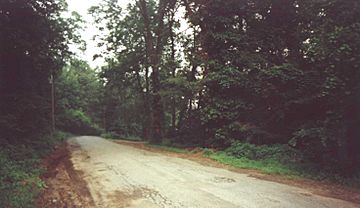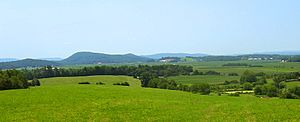Pochuck Mountain facts for kids
Quick facts for kids Pochuck Mountain |
|
|---|---|

White Birch Road within the Scenic Lakes community leading down one of the southwestern peaks of Pochuck Mountain.
|
|
| Highest point | |
| Elevation | 1,194 ft (364 m) |
| Prominence | 695 ft (212 m) |
| Geography | |
| Location | Sussex County, New Jersey / Orange County, New York, U.S. |
| Parent range | Appalachian Mountains |
| Topo map | USGS Pochuck Mountain |
Pochuck Mountain is a long, narrow mountain ridge found in the Appalachian Mountains. Most of this mountain is in Vernon Township, Sussex County, New Jersey. A small part of it also reaches into Hardyston Township and even crosses into Orange County, New York.
Pochuck Mountain is important because it sits on the eastern edge of a large lowland area called the Great Appalachian Valley. It also helps separate the water that flows into the Wallkill River from the water that flows into Pochuck Creek. These two rivers eventually meet at a place called Pochuck Neck, which is where the mountain ridge ends.
Contents
What's in a Name?
The name "Pochuck" comes from the Lenape language. It means "out-of-the-way place." This name might have been chosen because Pochuck Mountain is a bit separate from other mountains nearby. It's set apart by the Vernon Valley. Because it stands out on its own, Pochuck Mountain has a high prominence. This means its peak is much higher than the land around its base. Its prominence is about 695 feet.
Where is Pochuck Mountain?
Pochuck Mountain and Wawayanda Mountain (which is to the east) create the edges of the Vernon Valley. This valley is a key area in New Jersey known for farming and mining. The Pochuck Creek drains this valley. To the northwest of the mountain is the Black Dirt Region, which is drained by the Wallkill River.
Both of these valleys are part of the much larger Great Appalachian Valley. This long lowland region stretches for hundreds of miles through the Appalachian Mountains. The way Pochuck Mountain is positioned makes the Vernon Valley feel a bit separate from the rest of this big valley.
Water on the Mountain
All the water that falls on Pochuck Mountain eventually flows into the Wallkill River or its smaller stream, Pochuck Creek. This means the entire area is part of the Wallkill River's watershed. The Wallkill River flows north until it joins Rondout Creek in New York. Rondout Creek then flows into the Hudson River. Finally, the Hudson River empties into the Atlantic Ocean near New York Harbor.
Several lakes are found on Pochuck Mountain. These include Lake Glenwood, Lake Pochung, Lake Wallkill, Pleasant Valley Lake, Tall Timbers Lake, Lake Panorama, Louemma Lake, and Scenic Lakes. The Scenic Lakes are two lakes made by people in the Scenic Lakes community. People use these lakes for fun activities like fishing, swimming, boating, and ice skating in winter.
Mountain Paths and Roads
Several roads cross Pochuck Mountain, acting like passes that separate different parts of the ridge:
- Lake Pochung Road separates the highest point (the summit) from the peaks to the southwest.
- CR 565 (Glenwood Road) separates the summit from the northern peaks.
- CR 641 (Drew Mountain Road) separates the summit from the northeastern peaks.
- Glenwood Mountain Road separates some of the northeastern peaks from each other.
The Appalachian Trail
The famous Appalachian Trail also crosses over Pochuck Mountain. It runs along the top of the ridge within Wawayanda State Park, just north of the mountain's highest point.
What is Pochuck Mountain Made Of?
Pochuck Mountain is part of a geological area called the Reading Prong. This area is made of very old, hard rocks called metamorphic rocks. These are rocks that have changed over time due to heat and pressure deep inside the Earth. Pochuck Mountain is the northernmost part of the Reading Prong in New Jersey. The rocks here are similar to those found in nearby Wawayanda Mountain.
These ancient, hard rocks are part of what geologists call the Crystalline Appalachians. This part of the Appalachian Mountains stretches from Vermont in the north all the way to the Blue Ridge Mountains in the south. These "crystalline" mountains are different from other parts of the Appalachians, like the Kittatinny Mountains, which are made of softer, layered rocks called sedimentary rocks.
Animals of Pochuck Mountain
Many different Mammals live on Pochuck Mountain. You might spot black bears, white-tailed deer, opossums, foxes, raccoons, squirrels, skunks, and coyotes. Other animals include bobcats, fishers, porcupines, bats, chipmunks, groundhogs, and small field mice.
Mountain Industries
Even though many homes are built on Pochuck Mountain today, the area has a history of mining. In the past, around 1871, a railroad line helped transport iron ore from mines on the eastern side of the mountain.
Today, a company called Raia Industries uses a large part of the southwestern side of the mountain for mining a type of rock called gneiss. This mining has caused some worries among people living nearby. They are concerned about how it affects the environment and the loss of natural homes for local animals and birds that migrate through the area.


